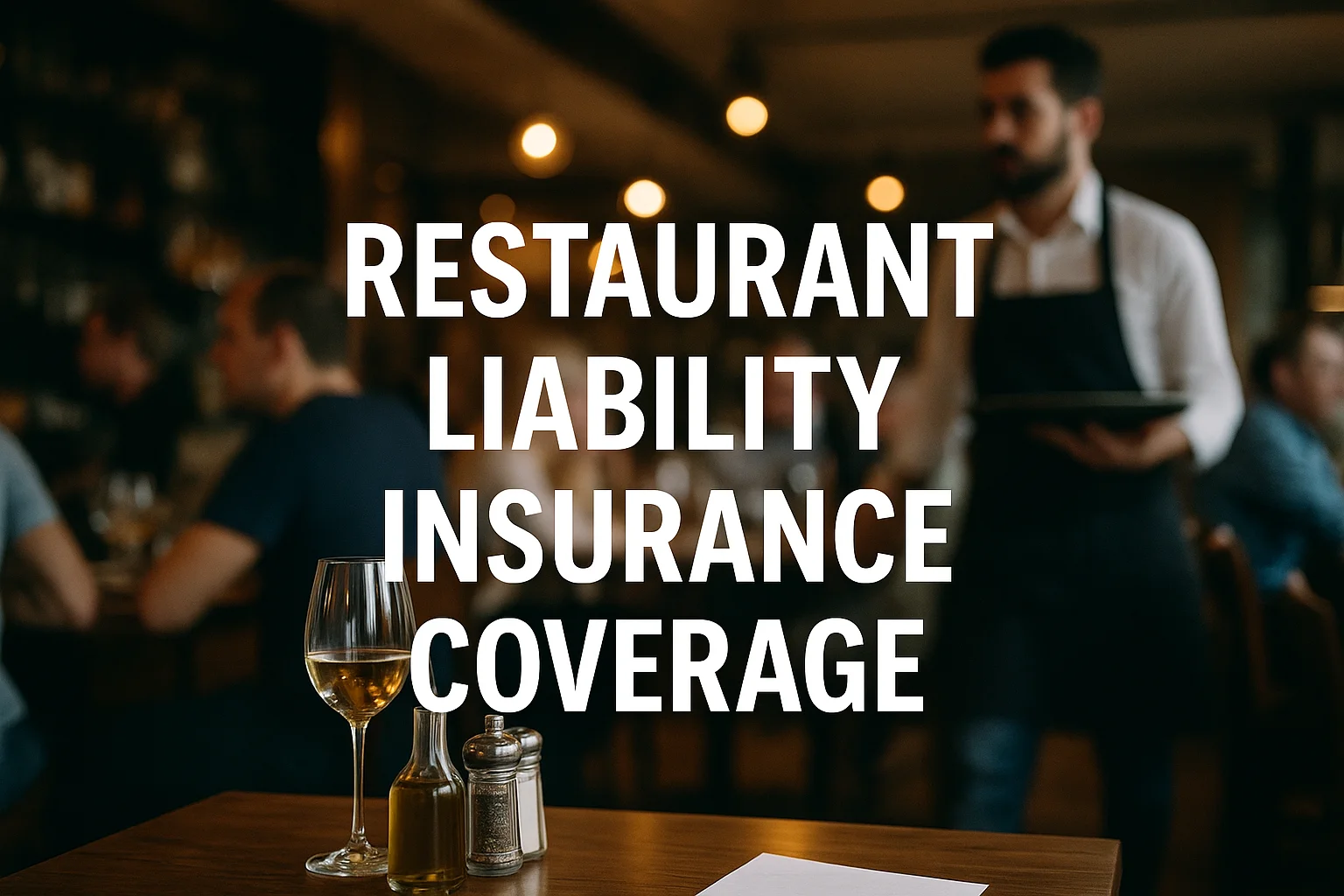1. Introduction to Restaurant Liability Insurance
Every successful restaurant owner knows that good food and excellent service are just part of the equation. Behind the scenes, a robust insurance policy acts as a silent protector, safeguarding against financial disasters that could otherwise shutter your business permanently.
Restaurant liability insurance is designed specifically to handle the unique risks associated with the food service industry. Whether you're operating a cozy café or a bustling downtown restaurant, liability insurance provides coverage for customer injuries, property damage, and legal claims.
2. Why Restaurant Liability Insurance is Critical
Restaurants face numerous risks daily. Here’s why liability insurance isn't optional:
- Slip and Falls: Customers can sue for injuries sustained on your premises.
- Foodborne Illnesses: Serving contaminated food can result in serious lawsuits.
- Property Damage: A kitchen fire could damage not just your restaurant but neighboring businesses too.
- Employee Lawsuits: Even with workers' compensation, an employee could sue for negligence.
Without proper insurance, you risk paying these costs out of pocket, potentially bankrupting your business.
3. Types of Restaurant Liability Insurance
Understanding the types of coverage available helps you build a strong protection plan:
- General Liability Insurance: Covers third-party bodily injury, property damage, and advertising injury.
- Product Liability Insurance: Protects against claims from food-related illnesses.
- Liquor Liability Insurance: If your restaurant serves alcohol, this covers damages related to intoxicated patrons.
- Workers' Compensation Insurance: Mandatory in most states; covers employee injuries at work.
- Commercial Property Insurance: Covers damage to the building and equipment from events like fires or floods.
- Cyber Liability Insurance: Increasingly important to protect against online payment breaches and cyberattacks.
4. What Does Restaurant Liability Insurance Cover?
Restaurant liability insurance is designed to be comprehensive, but understanding exactly what it covers can make the difference between a well-protected business and unexpected financial exposure. Here are the core components:
- Customer Injuries: Covers medical costs if a customer is injured on your premises.
- Property Damage: Covers accidental damage to someone else’s property caused by your restaurant operations.
- Legal Defense: Covers legal fees, court costs, and settlement payouts in case of a lawsuit.
- Food Poisoning Claims: Coverage in the event someone falls ill from your food or beverages.
- Liquor-Related Incidents: If your restaurant serves alcohol, liquor liability coverage is crucial to protect against intoxication-related damages or injuries.
Depending on your policy, there might also be optional endorsements, such as umbrella policies for higher limits or coverage for special events like catering jobs or food festivals.
5. Costs of Restaurant Liability Insurance
One of the first questions restaurant owners ask is, "How much does it cost?" While prices vary, here’s a rough guide based on recent 2025 industry data:
- Small cafés or food trucks: Around $1,000–$2,500 per year
- Mid-sized restaurants: Between $2,500–$6,000 per year
- Large establishments (with alcohol): $6,000–$15,000+ per year
It’s important to note that bundling policies together (for example, property insurance + liability) often results in significant discounts. Many providers offer a Business Owner’s Policy (BOP) to combine general liability and property coverage at a reduced rate.
6. Factors Affecting Insurance Premiums
Several factors impact your insurance rates:
- Restaurant Size and Revenue: Higher foot traffic and revenue usually mean higher premiums.
- Menu Offerings: Serving alcohol, seafood, or raw meats may increase your risk profile.
- Location: Restaurants in high-crime or disaster-prone areas pay more.
- Claims History: A clean record helps lower costs, while previous lawsuits can drive up your rates.
- Employee Numbers: More employees mean higher workers’ compensation costs and general liability exposure.
- Safety Measures: Implementing rigorous safety protocols (like non-slip mats and food handling certifications) can lower premiums.
7. How to Choose the Right Insurance Plan
Choosing the right insurance isn’t just about picking the cheapest policy. Here’s what to consider:
- Evaluate Your Risks: Understand specific risks based on your business model (e.g., dine-in vs. delivery-only restaurants).
- Look for Customizable Coverage: Not all policies are created equal; make sure your unique risks are covered.
- Check Provider Reputation: Research how insurers handle claims — fast, fair handling is critical.
- Ask About Bundles: Business Owner’s Policies (BOPs) often combine necessary protections at a discount.
- Review Exclusions Carefully: Read the fine print. Know what is excluded to avoid nasty surprises later.
8. Common Exclusions and Limitations
Not everything is covered under standard liability insurance. Be aware of common exclusions:
- Intentional Acts: Insurance won’t cover damages resulting from intentional harm.
- Employee Injuries: Typically, this is covered under a separate workers’ compensation policy.
- Pollution Events: Spills or contamination incidents may require an environmental endorsement.
- Professional Errors: For example, a poorly trained chef leading to food poisoning might need special professional liability coverage.
- Acts of War or Terrorism: Generally excluded unless you purchase special endorsements.
Review your policy closely and talk to your agent about supplemental policies if needed.
9. Real-Life Claims Examples
Understanding how restaurant liability insurance works in practice can help you appreciate its true value. Here are a few real-world cases:
Case 1: Customer Slip-and-Fall
A customer entering a local café slipped on a recently mopped floor without proper signage. The resulting lawsuit demanded $45,000 for medical bills and emotional distress. Thankfully, the café's general liability insurance covered the settlement and legal fees, costing the owner nothing out-of-pocket beyond the deductible.
Case 2: Food Poisoning Incident
A small bistro catered a wedding where several guests became ill after consuming undercooked chicken. Lawsuits and bad publicity followed. Their product liability insurance handled settlements totaling over $80,000, preserving the restaurant’s financial future.
Case 3: Property Damage to Neighboring Business
A fire started in the kitchen of a sushi restaurant and spread to adjacent shops. The commercial property insurance and liability insurance together covered over $1.2 million in damages to neighboring properties and business interruption claims.
Each of these cases highlights how vital it is to have thorough insurance coverage tailored to your restaurant’s operations.
10. How to File a Restaurant Insurance Claim
If you ever need to file a claim, following the right steps can ensure a smooth process:
- Document the Incident: Take photos, collect witness statements, and write a detailed description.
- Notify Your Insurance Provider Immediately: Most policies require timely notification to honor claims.
- Complete Necessary Paperwork: Fill out the insurer’s claim forms accurately and completely.
- Work with Adjusters: Cooperate fully with insurance adjusters investigating the claim.
- Track All Related Expenses: Keep receipts and records of costs related to the incident for reimbursement.
Speed, transparency, and detailed documentation will help you achieve a favorable outcome.
11. Tips for Reducing Your Restaurant's Liability Risk
While insurance is your safety net, smart risk management reduces the chances of needing to use it. Here’s how to proactively protect your business:
- Invest in Staff Training: Proper food handling, customer service etiquette, and safety protocols are vital.
- Implement Regular Inspections: Check floors, kitchens, and bathrooms for hazards daily.
- Use Proper Signage: Wet floors, hot surfaces, and restricted areas should be clearly marked.
- Keep Detailed Records: Incident logs, maintenance schedules, and employee training documentation can be valuable in case of claims.
- Update Insurance Annually: As your business grows, your insurance needs may change. Review policies each year with your agent.
- Secure Your Digital Systems: If you accept digital payments or store customer data, cyber liability coverage and strong cybersecurity practices are essential.
These proactive steps can also lead to lower insurance premiums over time, as insurers often reward businesses with lower risk profiles.
12. Conclusion: Securing Your Future
Owning and operating a restaurant is a rewarding endeavor, but it's fraught with potential risks. Restaurant liability insurance coverage acts as a critical buffer, ensuring that a single accident or lawsuit doesn’t derail your hard-earned success.
From slip-and-fall incidents to foodborne illness claims, the right coverage shields you financially and emotionally. As the restaurant industry continues to evolve, so too should your insurance policies — adapting to new risks like cyber threats and delivery service liabilities.
Remember, insurance isn't just about fulfilling legal requirements; it's about peace of mind. It's the foundation that lets you focus on what you love: serving delicious food, creating memorable experiences, and growing your business.
Protect your passion. Invest in the right restaurant liability insurance today.
Need help finding a trusted insurance provider? Consult industry experts, read reviews, and don’t hesitate to get multiple quotes before making your decision. Your future depends on it!



0 Comments